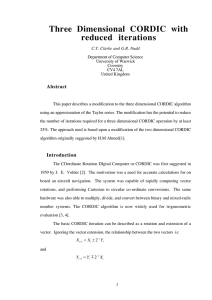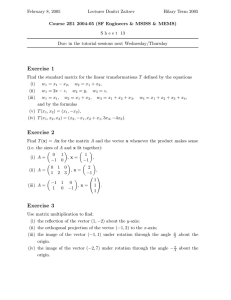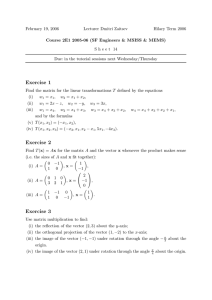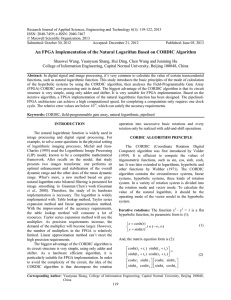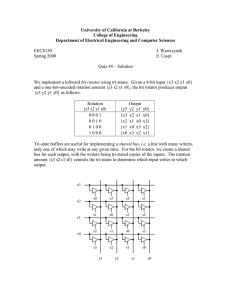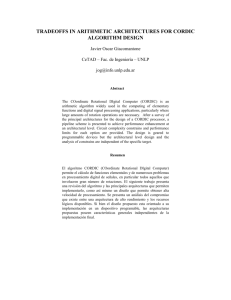A survey of CORDIC algorithms for FPGA based computers
advertisement
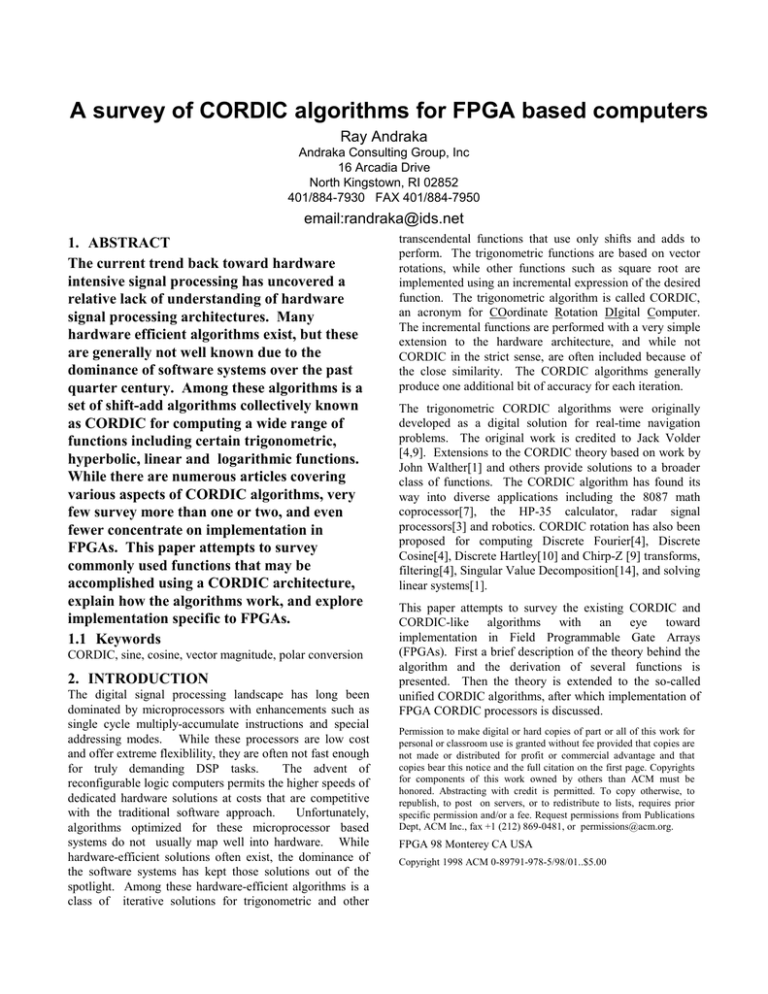
A survey of CORDIC algorithms for FPGA based computers
Ray Andraka
Andraka Consulting Group, Inc
16 Arcadia Drive
North Kingstown, RI 02852
401/884-7930 FAX 401/884-7950
email:randraka@ids.net
1. ABSTRACT
The current trend back toward hardware
intensive signal processing has uncovered a
relative lack of understanding of hardware
signal processing architectures. Many
hardware efficient algorithms exist, but these
are generally not well known due to the
dominance of software systems over the past
quarter century. Among these algorithms is a
set of shift-add algorithms collectively known
as CORDIC for computing a wide range of
functions including certain trigonometric,
hyperbolic, linear and logarithmic functions.
While there are numerous articles covering
various aspects of CORDIC algorithms, very
few survey more than one or two, and even
fewer concentrate on implementation in
FPGAs. This paper attempts to survey
commonly used functions that may be
accomplished using a CORDIC architecture,
explain how the algorithms work, and explore
implementation specific to FPGAs.
1.1 Keywords
CORDIC, sine, cosine, vector magnitude, polar conversion
2. INTRODUCTION
The digital signal processing landscape has long been
dominated by microprocessors with enhancements such as
single cycle multiply-accumulate instructions and special
addressing modes. While these processors are low cost
and offer extreme flexiblility, they are often not fast enough
for truly demanding DSP tasks.
The advent of
reconfigurable logic computers permits the higher speeds of
dedicated hardware solutions at costs that are competitive
with the traditional software approach.
Unfortunately,
algorithms optimized for these microprocessor based
systems do not usually map well into hardware. While
hardware-efficient solutions often exist, the dominance of
the software systems has kept those solutions out of the
spotlight. Among these hardware-efficient algorithms is a
class of iterative solutions for trigonometric and other
transcendental functions that use only shifts and adds to
perform. The trigonometric functions are based on vector
rotations, while other functions such as square root are
implemented using an incremental expression of the desired
function. The trigonometric algorithm is called CORDIC,
an acronym for COordinate Rotation DIgital Computer.
The incremental functions are performed with a very simple
extension to the hardware architecture, and while not
CORDIC in the strict sense, are often included because of
the close similarity. The CORDIC algorithms generally
produce one additional bit of accuracy for each iteration.
The trigonometric CORDIC algorithms were originally
developed as a digital solution for real-time navigation
problems. The original work is credited to Jack Volder
[4,9]. Extensions to the CORDIC theory based on work by
John Walther[1] and others provide solutions to a broader
class of functions. The CORDIC algorithm has found its
way into diverse applications including the 8087 math
coprocessor[7], the HP-35 calculator, radar signal
processors[3] and robotics. CORDIC rotation has also been
proposed for computing Discrete Fourier[4], Discrete
Cosine[4], Discrete Hartley[10] and Chirp-Z [9] transforms,
filtering[4], Singular Value Decomposition[14], and solving
linear systems[1].
This paper attempts to survey the existing CORDIC and
CORDIC-like algorithms with an eye toward
implementation in Field Programmable Gate Arrays
(FPGAs). First a brief description of the theory behind the
algorithm and the derivation of several functions is
presented. Then the theory is extended to the so-called
unified CORDIC algorithms, after which implementation of
FPGA CORDIC processors is discussed.
Permission to make digital or hard copies of part or all of this work for
personal or classroom use is granted without fee provided that copies are
not made or distributed for profit or commercial advantage and that
copies bear this notice and the full citation on the first page. Copyrights
for components of this work owned by others than ACM must be
honored. Abstracting with credit is permitted. To copy otherwise, to
republish, to post on servers, or to redistribute to lists, requires prior
specific permission and/or a fee. Request permissions from Publications
Dept, ACM Inc., fax +1 (212) 869-0481, or permissions@acm.org.
FPGA 98 Monterey CA USA
Copyright 1998 ACM 0-89791-978-5/98/01..$5.00
3. CORDIC THEORY: AN ALGORITHM
FOR VECTOR ROTATION
All of the trigonometric functions can be computed or
derived from functions using vector rotations, as will be
discussed in the following sections. Vector rotation can
also be used for polar to rectangular and rectangular to
polar conversions, for vector magnitude, and as a building
block in certain transforms such as the DFT and DCT. The
CORDIC algorithm provides an iterative method of
performing vector rotations by arbitrary angles using only
shifts and adds. The algorithm, credited to Volder[4], is
derived from the general (Givens) rotation transform:
y’= y cos φ + x sin φ
which rotates a vector in a Cartesian plane by the angle φ.
These can be rearranged so that:
x ’= cos φ ⋅ [x − y tan φ]
y ’= cos φ ⋅ [y + x tan φ]
So far, nothing is simplified. However, if the rotation
angles are restricted so that tan(φ)=±2-i, the multiplication
by the tangent term is reduced to simple shift operation.
Arbitrary angles of rotation are obtainable by performing a
series of successively smaller elementary rotations. If the
decision at each iteration, i, is which direction to rotate
rather than whether or not to rotate, then the cos(δi) term
becomes a constant (because cos(δi) = cos(-δi)). The
iterative rotation can now be expressed as:
[
= K [y
y i +1
i
i
+ x i ⋅ d i ⋅ 2 −i
( )
z i+1 = z i − d i ⋅ tan −1 2 − i
Obviously, in cases where the angle is useful in the
arctangent base, this extra element is not needed.
x ’= x cos φ − y sin φ
xi +1 = Ki xi − yi ⋅ d i ⋅ 2 −i
system based on binary arctangents. Conversions between
this angular system and any other can be accomplished
using a look-up. A better conversion method uses an
additional adder-subtractor that accumulates the elementary
rotation angles at each iteration. The elementary angles can
be expressed in any convenient angular unit. Those angular
values are supplied by a small lookup table (one entry per
iteration) or are hardwired, depending on the
implementation. The angle accumulator adds a third
difference equation to the CORDIC algorithm:
The CORDIC rotator is normally operated in one of two
modes. The first, called rotation by Volder[4], rotates the
input vector by a specified angle (given as an argument).
The second mode, called vectoring, rotates the input vector
to the x axis while recording the angle required to make that
rotation.
In rotation mode, the angle accumulator is initialized with
the desired rotation angle. The rotation decision at each
iteration is made to diminish the magnitude of the residual
angle in the angle accumulator. The decision at each
iteration is therefore based on the sign of the residual angle
after each step. Naturally, if the input angle is already
expressed in the binary arctangent base, the angle
accumulator may be eliminated. For rotation mode, the
CORDIC equations are:
xi+1 = xi − yi ⋅ d i ⋅ 2− i
]
]
where:
yi+1 = yi + xi ⋅ d i ⋅ 2− i
( )
z i+1 = z i − d i ⋅ tan −1 2− i
where
Ki = cos(tan −1 2 − i ) = 1
1 + 2 −2i
d i = ±1
which provides the following result:
Removing the scale constant from the iterative equations
yields a shift-add algorithm for vector rotation. The
product of the Ki’s can be applied elsewhere in the system
or treated as part of a system processing gain. That product
approaches 0.6073 as the number of iterations goes to
infinity. Therefore, the rotation algorithm has a gain, An,
of approximately 1.647. The exact gain depends on the
number of iterations, and obeys the relation
An = ∏ 1 + 2
di= -1 if zi < 0, +1 otherwise
−2 i
n
The angle of a composite rotation is uniquely defined by the
sequence of the directions of the elementary rotations. That
sequence can be represented by a decision vector. The set
of all possible decision vectors is an angular measurement
[
= A [y
]
sin z ]
x n = An x 0 cos z 0 − y 0 sin z 0
yn
n
0
cos z 0 + x 0
0
zn = 0
An = ∏ 1 + 2 − 2i
n
In the vectoring mode, the CORDIC rotator rotates the
input vector through whatever angle is necessary to align
the result vector with the x axis. The result of the vectoring
operation is a rotation angle and the scaled magnitude of
the original vector (the x component of the result). The
vectoring function works by seeking to minimize the y
component of the residual vector at each rotation. The sign
of the residual y component is used to determine which
direction to rotate next. If the angle accumulator is
initialized with zero, it will contain the traversed angle at
the end of the iterations. In vectoring mode, the CORDIC
equations are:
xi+1 = xi − yi ⋅ d i ⋅ 2− i
3.1 Sine and Cosine
yi+1 = yi + xi ⋅ d i ⋅ 2− i
z i+1 = z i − d i ⋅ tan
−1
(2 )
−i
where
di= +1 if yi < 0, -1 otherwise.
Then:
x n = An x 02 + y 02
yn = 0
z n = z 0 + tan −1
y0
x0
An = ∏ 1 + 2 −2i
n
The CORDIC rotation and vectoring algorithms as stated
are limited to rotation angles between -π/2 and π/2. This
limitation is due to the use of 20 for the tangent in the first
iteration. For composite rotation angles larger than π/2, an
additional rotation is required. Volder[4] describes an
initial rotation ±π/2. This gives the correction iteration:
x ’= − d ⋅ y
y’= d ⋅ x
z ’= z + d ⋅ π 2
where
The CORDIC rotator described is usable to compute
several trigonometric functions directly and others
indirectly. Judicious choice of initial values and modes
permits direct computation of sine, cosine, arctangent,
vector magnitude and transformations between polar and
Cartesian coordinates.
d = +1 if y<0, -1 otherwise.
There is no growth for this initial rotation. Alternatively, an
initial rotation of either π or 0 can be made, avoiding the
reassignment of the x and y components to the rotator
elements. Again, there is no growth due to the initial
rotation:
x ’= d ⋅ x
y’= d ⋅ y
z’ = z if d= 1, or z - π if d= -1
d = -1 if x<0, +1 otherwise.
Both reduction forms assume a modulo 2π representation of
the input angle. The style of first reduction is more
consistent with the succeeding rotations, while the second
reduction may be more convenient when wiring is
restricted, as is often the case with FPGAs.
The rotational mode CORDIC operation can simultaneously
compute the sine and cosine of the input angle. Setting the
y component of the input vector to zero reduces the rotation
mode result to:
x n = An ⋅ x 0 cos z 0
y n = An ⋅ x 0 sin z 0
By setting x0 equal to 1/ An, the rotation produces the
unscaled sine and cosine of the angle argument, z0. Very
often, the sine and cosine values modulate a magnitude
value. Using other techniques (e.g., a look up table)
requires a pair of multipliers to obtain the modulation. The
CORDIC technique performs the multiply as part of the
rotation operation, and therefore eliminates the need for a
pair of explicit multipliers. The output of the CORDIC
rotator is scaled by the rotator gain. If the gain is not
acceptable, a single multiply by the reciprocal of the gain
constant placed before the CORDIC rotator will yield
unscaled results. It is worth noting that the hardware
complexity of the CORDIC rotator is approximately
equivalent to that of a single multiplier with the same word
size.
3.2 Polar to Rectangular Transformation
A logical extension to the sine and cosine computer is a
polar to Cartesian coordinate transformer.
The
transformation from polar to Cartesian space is defined by:
x = rcosθ
y = rsinθ
As pointed out above, the multiplication by the magnitude
comes for free using the CORDIC rotator.
The
transformation is accomplished by selecting the rotation
mode with x0=polar magnitude, z0=polar phase, and y0=0.
The vector result represents the polar input transformed to
Cartesian space. The transform has a gain equal to the
rotator gain, which needs to be accounted for somewhere in
the system. If the gain is unacceptable, the polar magnitude
may be multiplied by the reciprocal of the rotator gain
before it is presented to the CORDIC rotator.
3.3 General vector rotation
The rotation mode CORDIC rotator is also useful for
performing general vector rotations, as are often
encountered in motion correction and control systems. For
general rotation, the 2 dimensional input vector is presented
to the rotator inputs. The rotator rotates the vector through
the desired angle. The output is scaled by the CORDIC
rotator gain, which must be accounted for elsewhere in the
system. If the scaling is unacceptable, a pair of constant
multipliers is required to compensate for the gain.
CORDIC rotators may be cascaded in a tree architecture for
general rotation in n-dimensions. Some optimization of
multidimensional rotation is possible to permit
computational savings over the general n-dimensioned case,
as reported by Hsiao et al. [4]
3.4 Arctangent
The arctangent, θ=Atan(y/x), is directly computed using
the vectoring mode CORDIC rotator if the angle
accumulator is initialized with zero. The argument must be
provided as a ratio expressed as a vector (x, y). Presenting
the argument as a ratio has the advantage of being able to
represent infinity (by setting x=0). Since the arctangent
result is taken from the angle accumulator, the CORDIC
rotator growth does not affect the result.
z n = z 0 + tan −1
y0
x0
3.5 Vector Magnitude
The vectoring mode CORDIC rotator produces the
magnitude of the input vector as a byproduct of computing
the arctangent. After the vectoring mode rotation, the
vector is aligned with the x axis. The magnitude of the
vector is therefore the same as the x component of the
rotated vector. This result is apparent in the result
equations for the vector mode rotator:
x n = An x 02 + y 02
The magnitude result is scaled by the processor gain, which
needs to be accounted for elsewhere in the system. This
implementation of vector magnitude has a hardware
complexity of roughly one multiplier of the same width.
The CORDIC implementation represents a significant
hardware savings over an equivalent Pythagorean
processor. The accuracy of the magnitude result improves
by 2 bits for each iteration performed.
3.6 Cartesian to Polar transformation
The Cartesian to Polar transformation consists of finding
the magnitude (r=sqrt(x2+y2)) and phase angle (φ=atan[y/x])
of the input vector, (x, y). The reader will immediately
recognize that both functions are provided simultaneously
by the vectoring mode CORDIC rotator. The magnitude of
the result will be scaled by the CORDIC rotator gain, and
should be accounted for elsewhere in the system. If the
gain is unacceptable, it can be corrected by multiplying the
resulting magnitude by the reciprocal of the gain constant.
3.7 Inverse CORDIC functions
In most cases, if a function can be generated by a CORDIC
style computer, its inverse can also be computed. Unless
the inverse is calculable by changing the mode of the
rotator, its computation normally involves comparing the
output to a target value. The CORDIC inverse is illustrated
by the Arcsine function.
3.8 Arcsine and Arccosine
The Arcsine can be computed by starting with a unit vector
on the positive x axis, then rotating it so that its y
component is equal to the input argument. The arcsine is
then the angle subtended to cause the y component of the
rotated vector to match the argument. The decision
function in this case is the result of a comparison between
the input value and the y component of the rotated vector at
each iteration:
xi+1 = xi − yi ⋅ d i ⋅ 2− i
yi+1 = yi + xi ⋅ d i ⋅ 2− i
( )
z i+1 = z i − d i ⋅ tan −1 2− i
where
di= +1 if yi < c, -1 otherwise, and
c = input argument.
Rotation produces the following result:
xn =
(An ⋅ x0 )2 − c 2
yn = c
c
z n = z 0 + arcsin
An ⋅ x0
An = ∏ 1 + 2 −2i
n
The arcsine function as stated above returns correct angles
for inputs -1 < c/Anx0 < 1, although the accuracy suffers as
the input approaches ±1 (the error increases rapidly for
inputs larger than about 0.98). This loss of accuracy is due
to the gain of the rotator. For angles near the y axis, the
rotator gain causes the rotated vector to be shorter than the
reference (input), so the decisions are made improperly.
The gain problems can be corrected using a “double
iteration algorithm”[9] at the cost of an increase in
complexity.
The Arccosine computation is similar, except the difference
between the x component and the input is used as the
decision function. Without modification, the arccosine
algorithm works only for inputs less than 1/An, making the
double iteration algorithm a necessity. The Arccosine
could also be computed by using the arcsine function and
subtracting π/2 from the result, followed by an angular
reduction if the result is in the fourth quadrant.
3.9 Extension to Linear functions
A simple modification to the CORDIC equation permits the
computation of linear functions:
xi+1 = xi − 0 ⋅ yi ⋅ d i ⋅ 2− i = xi
yi+1 = yi + xi ⋅ d i ⋅ 2− i
( )
z i+1 = z i − d i ⋅ 2 − i
Then:
x n = An [x 0 cosh z0 + y 0 sinh z 0 ]
y n = An [ y 0 cosh z 0 + x 0 sinh z0 ]
zn = 0
An = ∏ 1 − 2 −2 i ≈ 0.80
n
For rotation mode (di= -1 if zi < 0, +1 otherwise) the linear
rotation produces:
x n = x0
In vectoring mode (di= +1 if
rotation produces:
yi < 0, -1 otherwise) the
x n = An x02 − y02
y n = y0 + x0 z0
zn = 0
yn = 0
This operation is similar to the shift-add implementation of
a multiplier, and as multipliers go is not an optimal
solution. The multiplication is handy in applications where
a CORDIC structure is already available. The vectoring
mode (di= +1 if yi < 0, -1 otherwise) is more interesting, as
it provides a method for evaluating ratios:
x n = x0
yn = 0
z n = z0 − y0 x0
The rotations in the linear coordinate system have a unity
gain, so no scaling corrections are required.
z n = z 0 + tanh −1
n
The elemental rotations in the hyperbolic coordinate system
do not converge. However, it can be shown[1] that
convergence is achieved if certain iterations (I=4, 13, 40,...,
k, 3k+1,...) are repeated.
The hyperbolic equivalents of all the functions discussed
for the circular coordinate system can be computed in a
similar fashion. Additionally, as Walther[1] points out, the
following functions can be derived from the CORDIC
functions:
tanα = sinα/cosα
The close relationship between the trigonometric and
hyperbolic functions suggests the same architecture can be
used to compute the hyperbolic functions. While, there is
early mention of using the CORDIC structure for
hyperbolic coordinate transforms [4], the first description of
the algorithm is that by Walther [1]. The CORDIC
equations for hyperbolic rotations are derived using the
same manipulations as those used to derive the rotation in
the circular coordinate system. For rotation mode these are:
tanhα = sinhα/coshα
yi+1 = yi + xi ⋅ d i ⋅ 2− i
( )
x0
An = ∏ 1 − 2 −2i
3.10 Extension to Hyperbolic Functions
xi+1 = xi + yi ⋅ di ⋅ 2 − i
y0
expα = sinhα + coshα
lnα = 2tanh-1[y/x] where x=α +1 and y=α-1
(α)1/2 = (x2-y2)1/2 where x=α+1/4 and y=α-1/4
It is worth noting the similarities between the CORDIC
equations for circular, linear, and hyperbolic systems. The
selection of coordinate system can be made by introducing
a mode variable that takes on values 1,0, or -1 for circular,
linear and hyperbolic systems respectively. The unified [1]
CORDIC iteration equations are then:
z i+1 = z i − d i ⋅ tanh −1 2− i
xi+1 = xi − m ⋅ yi ⋅ d i ⋅ 2 − i
di= -1 if zi < 0, +1 otherwise.
yi+1 = yi + xi ⋅ d i ⋅ 2 − i
z i+1 = z i − d i ⋅ ei
where
where ei is the elementary angle of rotation for iteration i in
-1 -i
the selected coordinate system. Specifically, ei = tan (2 )
-i
-1 -i
for m=1, ei = 2 for m=0, and ei = tanh (2 ) for m=-1.
This unification, due to Walther, permits the design of a
general purpose CORDIC processor.
3.11 Short cuts
For fixed angle rotations, as are encountered in such places
as fast Fourier Transforms (FFTs), the arctangent base
representation of the angle can be pre-computed and
applied directly to the CORDIC rotator. This hardwiring of
a fixed angle(s) eliminates the need for the angle
accumulator, which reduces the circuit complexity by about
25 percent. If the constraints on the decision variable are
relaxed to allow that variable to take on values of {-1,0,1}
instead of just {-1,1}, the number of iterations can also be
reduced. Iterations for which the decision variable is zero
pass the data unrotated, and can thus be eliminated. This
modification causes the gain to become a function of the
rotated angle, so it is only useful if the rotation angle is
fixed. Hu and Naganathan[10] propose a method of precomputing the recoded angles for the ternary decision
variable. This technique can significantly reduce the
complexity of on-line CORDIC processors used for fixed
angle rotations.
4. IMPLEMENTATION IN AN FPGA
There are a number of ways to implement a CORDIC
processor. The ideal architecture depends on the speed
versus area tradeoffs in the intended application. First we
will examine an iterative architecture that is a direct
translation from the CORDIC equations. From there, we
will look at a minimum hardware solution and a maximum
performance solution.
4.1 Iterative CORDIC Processors
An iterative CORDIC architecture can be obtained simply
by duplicating each of the three difference equations in
hardware as shown in Figure 1. The decision function, di, is
driven by the sign of the y or z register depending on
whether it is operated in rotation or vectoring mode. In
operation, the initial values are loaded via multiplexers into
the x, y and z registers. Then on each of the next n clock
cycles, the values from the registers are passed through the
shifters and adder-subtractors and the results placed back in
the registers. The shifters are modified on each iteration to
cause the desired shift for the iteration. Likewise, the ROM
address is incremented on each iteration so that the
appropriate elementary angle value is presented to the z
adder-subtractor. On the last iteration, the results are read
directly from the adder-subtractors. Obviously, a simple
state machine is required keep track of the current iteration,
and to select the degree of shift and ROM address for each
iteration.
The design depicted in Figure 1 uses word-wide data paths
(called bit-parallel design). The bit-parallel variable shift
shifters do not map well to FPGA architectures because of
the high fan-in required. If implemented, those shifters will
typically require several layers of logic (i.e., the signal will
need to pass through a number of FPGA cells). The result
is a slow design that uses a large number of logic cells.
x0
register
>>n
±
xn
-mdi
>>n
sgn(yi)
±
yn
di
register
y0
ROM
sgn(zi)
±
register
zn
-di
z0
Figure 1. Iterative CORDIC structure
A considerably more compact design is possible using bit
serial arithmetic. The simplified interconnect and logic in a
bit serial design allows it to work at a much higher clock
rate than the equivalent bit parallel design. Of course, the
design also needs to clocked w times for each iteration (w is
the width of the data word). The bit serial design consists
of three bit serial adder-subtractors, three shift registers and
a serial Read Only Memory (ROM). Each shift register has
a length equal to the word width. There is also some
gating or multiplexers to select taps off the shift registers
for the right shifted cross terms (shifting is accomplished
using bit delays in bit serial systems). The bit serial
CORDIC architecture is shown in Figure 2. In this design,
w clocks are required for each of the n iterations, where w is
precision of the adders. In operation, the load multiplexers
on the left are opened for w clock periods to initialize the x,
y and z registers (these registers could also be parallel
loaded to initialize). Once loaded, the data is shifted right
through the serial adder-subtractors and returned to the left
end of the register. Each iteration requires w clocks to
return the result to the register. At the beginning of each
iteration, the control state machine reads the sign of the y
(or z) register and sets the add/subtract controls
accordingly. The appropriate tap off the register for the
cross terms is also selected at the beginning of each
iteration. During the nth iteration, the results can be read
from the outputs of the serial adders while the next
initialization data is shifted into the registers.
x register
Serial
AdderSubtractor
x0
xn
sign to
controller
Serial
yn
AdderSubtractor
y0
y register
z register
z0
Serial ROM
Serial
AdderSubtractor
zn
Figure 2 Bit serial iterative CORDIC
The simplicity of the bit serial design is apparent from
figure 2. Even in this case, the wiring of the shift tap
multiplexers can present problems in some FPGAs (this is
one place where tri-state long lines can come in handy).
Even so, the interconnect is minimal and the logic between
registers is simple. This combination permits bit clock rates
near the maximum toggle frequency of the FPGA. The
possibility of using extreme bit clock frequencies makes up
for the large number of clock cycles required to complete
each rotation.
Now, if the design is in a Xilinx 4000E series part, the shift
registers can be implemented in the CLB RAM[2]. The
RAM emulates a shift register by incrementing the
read/write address after each access. The dual port
capability of the CLB RAM provides the capability to read
two locations in the 16x1 RAM simultaneously [9]. By
properly sequencing the second address, the effect of the
shift tap multiplexer is achieved without a physical
multiplexer. The result is the shift register and multiplexer
for word lengths up to 16 bits are implemented in a single
CLB (plus 8 CLBs for the 2 address sequencers and
iteration counter, which are shared by the three shifters).
The serial ROM also uses the CLB for data storage. One
CLB is required for every two iterations. The 16 bit, 8
iteration CORDIC processor shown in Figure 3 uses only
21 CLBs, and will run at bit rates up to about 90 MHz
(mainly limited by the RAM write cycle). This translates to
about a 1.5µS processing time, which is only about three
and a half times longer than the best one could expect from
the much larger bit parallel iterative solution.
4.2 On-Line CORDIC Processors
The CORDIC processors discussed so far are iterative,
which means the processor has to perform iterations at n
times the data rate. The iteration process can unrolled[18]
so that each of n processing elements always performs the
same iteration. An unrolled CORDIC processor is shown in
Figure 4. Unrolling the processor results in two significant
simplifications. First the shifters are each a fixed shift,
which means that they can be implemented in the wiring.
Second, the lookup values for the angle accumulator are
distributed as constants to each adder in the angle
accumulator chain. Those constants can be hardwired
instead of requiring storage space. The entire CORDIC
processor is reduced to an array of interconnected addersubtractors. The need for registers is also eliminated,
making the unrolled processor strictly combinatorial. The
delay through the resulting circuit would be substantial, but
the processing time is reduced from that required by the
iterative circuit (if by nothing else than the set-up and hold
times of the register). Most times, especially in an FPGA, it
does not make sense to use such a large combinatorial
circuit. The unrolled processor is easily pipelined by
inserting registers between the adder-subtractors. In the
case of most FPGA architectures there are already registers
present in each logic cell, so the addition of the pipeline
registers has no hardware cost.
x0
4
4
y0
4
4
z0
4
4
4
4
4
16x1
Dual Port
Sync Ram
Add/Subt
+/R
16x1
Dual Port
Sync Ram
Add/Subt
+/R
16x1
Dual Port
Sync Ram
Add/Subt
+/R
xn
yn
zn
16x8
ROM
4 bit
LFSR
(bit cnt)
4 bit
loadable
LFSR
4
4 bit
LFSR
(iteration)
Figure 3 Iterative bit serial design for Xilinx 4000E series
FPGA uses 21 CLBs
x0
y0
>>0
>>0
±
>>1
>>1
>>3
xn
±
>>3
±
const
sign
±
>>4
±
const
sign
±
yn
const
sign
±
±
const
sign
>>2
±
>>4
±
±
±
const
sign
±
±
>>2
z0
±
zn
Figure 4 Unrolled CORDIC processor
The unrolled processor can also be converted to a bit serial
design. Each adder subtractor is replaced by a serial addersubtractor, separated by w bit shift registers. The shift
registers are necessary to extract the sign of the y or z
element before the first bits (lsbs) reach the next addersubtractors. The right shifted cross terms are taken from
fixed taps in the shift registers. Some method of sign
extension for the shifted terms is required too. Figure 5
shows two iterations of a bit serial CORDIC processor
implemented in an Atmel 6005 or NSC Clay31 FPGA.
Notice the cross term is taken from different taps off the
shift register at each iteration. This particular processor is
used to compute vector magnitude. Since this is a vector
mode process and the result angle is not required, there is
no need for an angle accumulator. Figure 6 shows the
detail of the adder-subtractor for that design. The adder
subtractor in this case includes logic to extend the sign of
the shifted cross term and to reset the adder subtractor
between words. The entire 7 iteration design occupies
approximately 20% of the FPGA and runs at bit rates up to
125 Mhz [3].
Higher performance requires either multiple bit serial
processors running in parallel, or an unrolled parallel
pipeline. Until recently, FPGAs did not have the required
combination of logic and routing resource to build a
parallel processor. This barrier is mostly due to the large
amount of cross routing required between the x and y
registers at each pipeline stage.
Additionally, the
performance diminishes as the word width is increased
because of the carry propagation times across the adders.
The Xilinx 4000E series has sufficient routing to realize a
reasonably compact parallel CORDIC pipeline.
Its
dedicated carry logic provides acceptable performance for
the adders. Figure 7 shows a 14 bit, 5 iteration pipelined
CORDIC processor that fits comfortably in half of a 4013E.
That design, used for polar to Cartesian coordinate
transformations in a radar target generator, runs at 52 MHz
(clock rate and data rate) in an XC4013E-2.
Figure 5 two iterations of bit serial CORDIC pipeline in Atmel/NSC FPGA
ASNI
RNF
FDHA
FD
D
FI
Q
FID
FD
FDMUX
1
0
D
R
Q
FM
Q
D
R
FHC
Q
D
R
FDXOAN3
FFC
R
FDHA
FDHA
FDMUX
GCI
SX
1
0
D
D
Q
R
FSEX
D
Q
R
1
0
D
Q
FO
Q
D
R
FDMUX
RS
Q
FHS
FC
R
AS
FDN
Q
D
R
ASNO
R
FD
D
Q
ASO
R
Figure 6 detail of pipelined bit serial adder-subtractor in Atmel/NSC FPGA
Figure 7 section of parallel pipelined CORDIC can run at over 50 Megasamples per second in a Xilinx XC4013E-2
5. CONCLUSIONS
The CORDIC algorithms presented in this paper are well
known in the research and super-computing circles. It is,
however, my experience that the majority of today’s
hardware DSP designs are being done by engineers with
little or no background in hardware efficient DSP
algorithms. The new DSP designers must become familiar
with these algorithms and the techniques for implementing
them in FPGAs in order to remain competitive. The
CORDIC algorithm is a powerful tool in the DSP toolbox.
This paper shows that tool is available for use in FPGA
based computing machines, which are the likely basis for
the next generation DSP systems.
6.
REFERENCES
[1] Ahmed, H. M., Delosme, J.M., and Morf, M., "Highly
Concurrent Computing Structure for Matrix Arithmetic and
Signal Processing," IEEE Comput. Mag., Vol. 15, 1982,
pp. 65-82.
[2] Alfke, P., “Efficient Shift Registers, LFSR Counters,
and Long Pseudo Random Sequence Generators,” Xilinx
application note, August, 1995.
[3] Andraka, R. J., “Building a High Performance BitSerial Processor in an FPGA,” Proceedings of Design
SuperCon '96, Jan 1996. pp5.1 - 5.21
[4] Deprettere, E., Dewilde, P., and Udo, R., "Pipelined
CORDIC Architecture for Fast VLSI Filtering and Array
Processing," Proc. ICASSP'84, 1984, pp. 41.A.6.141.A.6.4
[5] Despain, A.M., "Fourier Transform Computations
Using CORDIC Iterations," IEEE Transactions on
Computers, Vol.23, 1974, pp. 993-1001.
[6] Duh, W.J., and Wu, J.L., "Implementing the Discrete
Cosine Transform by Using CORDIC Techniques,"
Proceedings the International Symposium on VLSI
Technology, Systems and Applications, Taipei, Taiwan,
1989, pp. 281-285
[7] Duprat, J. and Muller, J.M., "The CORDIC Algorithm:
New Results for Fast VLSI Implementation," IEEE
Transactions on Computers, Vol. 42, pp. 168-178, 1993.
[8] Hsiao, S.F. and Delosme, J.M., "The CORDIC
Householder Algorithm," Proceedings of the 10th
Symposium on Computer Arithmetic, pp. 256-263, 1991.
[9] Hu, Y.H., and Naganathan, S., "A Novel
Implementation of Chirp Z-Transformation Using a
CORDIC Processor," IEEE Transactions on ASSP, Vol.
38, pp. 352-354, 1990.
[10] Hu, Y.H., and Naganathan, S., "An Angle Recoding
Method for CORDIC Algorithm Implementation", IEEE
Transactions on Computers, Vol. 42, pp. 99-102, January
1993
[11] Knapp, S. K., “XC4000E Edge triggered and Dual
Port RAM Capability,” Xilinx application note, August 11,
1995
[12]Marchesi, M., Orlandi, G., and Piazza, F., "Systolic
Circuit for Fast Hartley Transform," Proceedings - IEEE
International Symposium on Circuits and Systems, Espoo,
Finland, June 1988, pp. 2685-2688
[13] Mazenc, C., Merrheim, X., and Muller, J.M.,
"Computing Functions Arccos and Arcsin Using CORDIC,"
IEEE Transactions on Computers, Vol. 42, pp. 118-122,
1993.
[14] Sibul, L.H. and Fogelsanger, A.L., "Application of
Coordinate Rotation Algorithm to Singular Value
Decomposition," IEEE Int. Symp. Circuits and Systems,
pp. 821-824, 1984.
[15] Volder, J., “Binary computation algorithms for
coordinate rotation and function generation,” Convair
Report IAR-1 148 Aeroelectrics Group, June 1956.
[16] Volder, J., “The CORDIC Trigonometric Computing
Technique,” IRE Trans. Electronic Computing, Vol EC-8,
pp330-334 Sept 1959.
[17] Walther, J.S., “A unified algorithm for elementary
functions,” Spring Joint Computer Conf., 1971, proc., pp.
379-385.
[18] Wang, S. and Piuri, V., "A Unified View of CORDIC
Processor Design", Application Specific Processors, Edited
by Earl E.Swartzlander, Jr., Ch. 5, pp. 121-160, Kluwer
Academic Press, November 1996.
